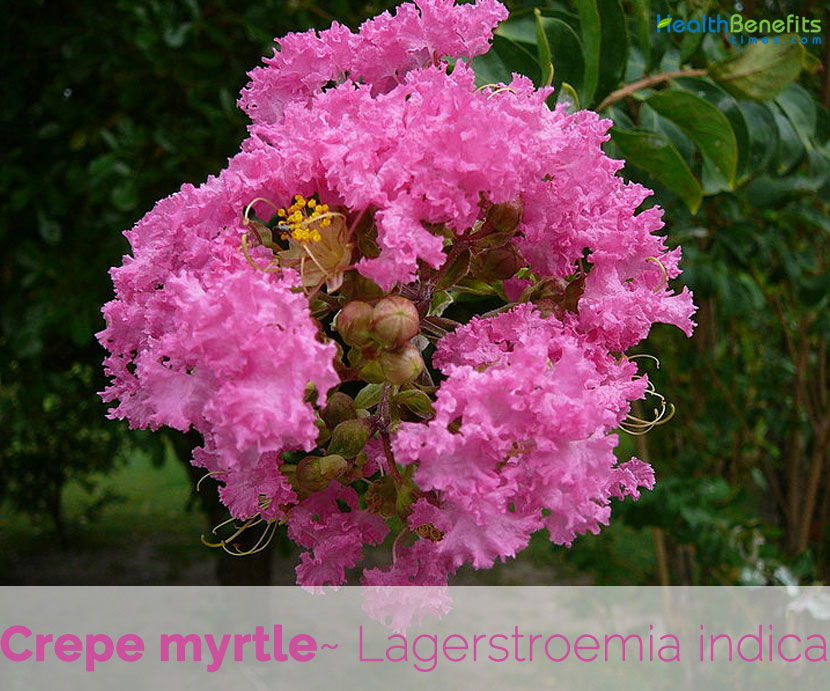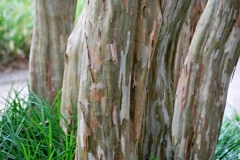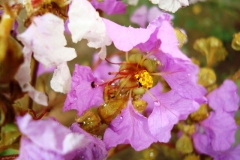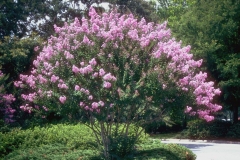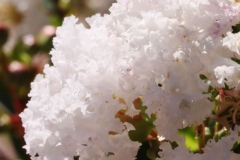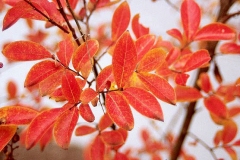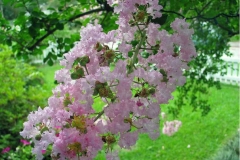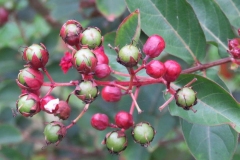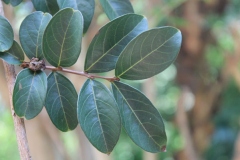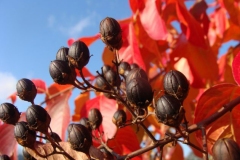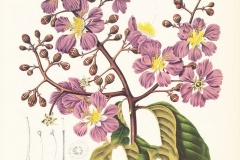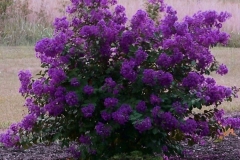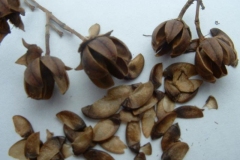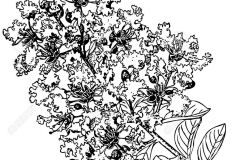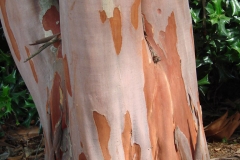| Crepe myrtle Quick Facts | |
|---|---|
| Name: | Crepe myrtle |
| Scientific Name: | Lagerstroemia indica |
| Origin | Temperate and tropical Asia. It has been widely cultivated as an ornamental and has become naturalized in Europe, America, and the Caribbean. |
| Colors | Green and succulent at first then ripening to dark brown or black |
| Shapes | Dry, 6-parted, capsule in upright spikes, each capsule measuring about 9 - 13 mm long |
| Taste | Bitter |
| Health benefits | Prevent Cancer Cells’ Growth, Maintain Bones’ Health, Beneficial for Constipation, Overcome Inflammation, Overcome Stroke, Overcome Diabetes, Overcoming Diarrhea, Works as Antivirus, Prevent Premature Aging, Antidote for High Blood Pressure Level, Cure For Urinary Conditions, Avoid Thrombus, Prevent Heart Attack, Prevent Arteriosclerosis Disease, Decrease the Level of Blood Cholesterol, Maintain Skin Health, Overcome Leucorrhoea, Overcome Coughing Up Blood, Overcome Toothache, Decrease the Bleeding on Labor, Release Toxic from the Body, Overcome Kidney Stone |
| Trunk/branches | Branches droop; showy; typically multi-trunked; no thorns |
| Bark | Smooth, tan orange, and flakes off in patches to reveal shades of brown, green, and reddish brown |
| Pruning requirement | Little required |
| Breakage | Resistant |
| Current year twig color | Brown, green |
| Current year twig thickness | Thin |
| Wood specific gravity | Unknown |
Leaves
Leaves of the Lagerstroemia indica cultivars are rounded, opposite or some leaves alternate or whorled, simple, elliptical, entire margin, 1 1/2 to 3 inches long, dark green above and paler below. Most hybrid cultivars have lance-shaped leaves up to 5 inches long and 3 inches wide while other species have even larger leaves. Leaves are often tinged red in the spring and turn dark green by summer. Several cultivars are known for new growth that is bronze, red or burgundy and some cultivars are claimed to have burgundy-colored foliage all summer. When the leaves fall in winter, crape myrtle becomes a living sculpture.
| Leaf arrangement | Opposite/sub-opposite |
| Leaf type | Simple |
| Leaf margin | Entire |
| Leaf shape | Elliptic (oval), obovate, oblong |
| Leaf venation | Pinnate |
| Leaf type and persistence | Deciduous |
| Leaf blade length | 1 to 3 inches |
| Leaf color | Dark green on top, pale green underneath |
| Fall color | Yellow, orange, red |
| Fall characteristic | Showy |
Flower
3 cm flowers are borne in rounded, slightly conical clusters, 15 – 30cm long, at the ends of branches. The clusters of flower buds develop at the tips of the shoots in spring and early summer and burst open to show their brilliant crinkled petals from June to September. The flowers are produced even on young plants.
| Flower color | White/cream/gray, pink, purple, lavender, red |
| Flower characteristics | Very showy; emerges in clusters on panicles |
| Flowering | Late spring to summer |
Fruit
Fertile flowers are followed by dry, 6-parted, capsule in upright spikes. Each capsule measures about 9 – 13 mm long, persistent through the winter. Capsules are green and succulent at first, then ripening to dark brown or black dryness. It splits along six or seven lines, producing teeth and releases numerous small winged seeds.
| Fruit shape | Oval, round |
| Fruit length | ¼ to ½ inch |
| Fruit covering | Dry or hard |
| Fruit color | Brown |
| Fruit characteristics | Does not attract wildlife; showy; fruit/leaves not a litter problem |
| Fruiting | Persists through winter |
Health benefits of Crepe Myrtle
Crepe myrtle has some contents that can be used as a medicine to cure some kind of diseases. Not only as medicine, can crepe myrtle also be used as herbs that are good for the health. Some contents of crepe myrtle are corosolic acid, saponin, tannin, and flavonoid. Some contents of crepe myrtle are also believed to be used as medicines and herb potions to maintain a good health. Listed below are some of the popular health benefits of Crepe Myrtle
1. Prevent Cancer Cells Growth
Crepe myrtle consists of saponin in it that can increase the immune system as antioxidant. Antioxidant in crepe myrtle can help prevent the cancer cells from growing inside the body. Besides saponin, crepe myrtle also contains flavonoid in it. Both are the compounds that can help prevent the cancer cells from growing inside the body.
2. Maintain Bones Health
Maintaining the health of your bones is very important, because bones functions as a frame and also as the pillar of the body. Lack of calcium and phosphor can also cause the bones to go porous. Besides calcium and phosphor, bones also need flavonoid compound to prevent them from going porous.
3. Beneficial for Constipation
Crepe myrtle is rich in dietary fibers. Hence, people suffering from constipation or hard stools can use the leaves, bark, and flowers of Jarul to ease the stools and smoothen the bowel movements. This, in turn, offers relief from constipation. Decoction made using the leaves has been quite popular as a purgative.
4. Overcome Inflammation
Inflammations often can happen because of viruses or bacteria. Preventing and overcoming inflammations can be done through using the crepe myrtle. Flavonoid inside crepe myrtle can prevent and overcome the inflammations from happening.
5, Overcome Stroke
Stroke happen because of the clogged cholesterol in the blood system, thus making the blood system blocked. Crepe myrtle is found to be able to smoothen the blood by decreasing the cholesterol level in the blood. If the blood runs smoothly, then someone will be avoided from the stroke and those who suffer from stroke can also get better by drinking crepe myrtle in the form of herb medicines.
6. Overcome Diabetes
Diabetes can happen because of the decreasing production of insulin and cause the blood sugar level in your system increases. Many ways had been used to increase the production of insulin to decrease the level of blood sugar. One of the natural ingredients that can help to increase the production of insulin is the content of corosolic acid inside the crepe myrtle’s leaves. Corosolic acid can be obtained through the extracts of crepe myrtle’s leaves.
7. Overcoming Diarrhea
Diarrhea can cause the sufferer to feel weak since it causes them to lose lots of liquids. Overcoming diarrhea traditionally is usually by making use of salt and young guava leaves. Besides using guava leaves, other traditional way to overcome diarrhea is by using the crepe myrtle. Crepe myrtle has this compound which is tannin that can harden the gastrointestinal wall to prevent the entering of liquids into the intestine that can cause diarrhea.
8. Works as Antivirus
Not only prevent the cancer cells’ growth, saponin in crepe myrtle can also help to prevent viruses from entering the body. Thus, the body can be avoided from some diseases that are caused by virus such as flu, herpes, and some other diseases caused by virus.
9. Prevent Premature Aging
Crepe myrtle is beneficial in preventing the premature aging. This is because the contents inside crepe myrtle can help to ward off free radicals from entering the body.
10. Antidote for High Blood Pressure Level
Researches are being conducted on the positive influence of this herb in curbing down the levels of blood pressure level, thus easing out hypertension and other associated health conditions. Just 2 cups of this tea made from dried leaves of this plant can help in easing hypertension. It ultimately prevents unwanted health conditions.
11. Cure For Urinary Conditions
An infusion or decoction prepared by using Crepe myrtle leaves is known to have a positive impact on various urinary disorders, including dysuria and renal inflammations. According to a research, including aqueous extracts of Crepe myrtle leaves in your diet could prevent and cure hyperuricemia.
12. Avoid Thrombus
Different than arteriosclerosis, thrombus does not obstruct the blood system, but it will stop the blood system from running since the blood will turn into lumps. Preventing thrombus can be done by using crepe myrtle, because crepe myrtle’s leaves contain flavonoid in it that can help to prevent blood turn into lumps.
13. Prevent Heart Attack
Same as stroke, heart attack can also happen because of blocked blood that is evidently go to the heart but gets clogged up because of cholesterol. The contents in crepe myrtle can help to decrease cholesterol, smoothen the run of blood system, and not only overcoming stroke but also prevent the heart attack from happening.
14. Prevent Arteriosclerosis Disease
Arteriosclerosis is a disease that can happen because of a fat growth on the arterial wall, thus making blood that runs to the brain and heart gets obstructed. Flavonoid in the crepe myrtle can help to prevent the arteriosclerosis from happening, thus smoothen the blood run to the brain and heart.
15. Decrease the Level of Blood Cholesterol
Accumulation of cholesterol in the blood system can cause some interference on the body’s health. Consuming crepe myrtle can help to decrease the level of blood cholesterol, thus smoothen the blood system and can prevent diseases that happen from blocked blood due to cholesterol from happening.
16. Maintain Skin Health
Contents inside crepe myrtle can help to protect skin’s health. The contents inside crepe myrtle can quickly heal skin diseases, and can also prevent skin from being exposed to free radicals. Thus, the skin health can be maintained.
17. Overcome Leucorrhoea
Some women may experience leucorrhoea. If not taken care immediately, leucorrhoea can result a fatal condition and cause infertility. Overcoming leucorrhoea can be done by drinking water from the crepe myrtle stew.
18. Overcome Coughing Up Blood
Experiencing blood cough or hemoptysis can cause other dangerous diseases if not taken care of immediately. One of the ways to overcome coughing up blood is to use the water from crepe myrtle’s stew.
19. Overcome Toothache
Some traits in crepe myrtle act just like how it can be an anti-inflammation, can also overcome toothache. Toothache can happen because of inflammation on the gum or bacteria on the teeth. Besides of anti-inflammation, contents inside crepe myrtle can also help to kill bacteria that can cause toothache.
20. Decrease the Bleeding on Labor
Some mother will experience severe bleeding after giving labor. To help decrease the bleeding, the water from crepe myrtle’s stew can be used for this.
21. Release Toxic from the Body
Inside the body, sometimes there are toxics that enter the body accidentally, caused by the air and also food. Not only to prevent diarrhea, but tannin compound inside crepe myrtle can also give benefits to help releasing the toxics from inside the body.
22. Overcome Kidney Stone
Make a stew out of crepe myrtle and drink the remaining water can help to destroy kidney stone that can disturb the kidney’s filtration function.
Traditional uses and benefits of Crepe myrtle
- Stem bark is febrifuge, stimulant and styptic.
- Bark, flowers and leaves are considered to be hydrogogue and a drastic purgative.
- Paste of the flowers is applied externally to cuts and wounds.
- Root is astringent, detoxicant and diuretic.
- Decoction of the flowers is used in the treatment of colds.
- Bark is also considered stimulant and febrifuge.
- Roots are astringent and used as gargle.
- Seeds have narcotic properties.
- Flowers and leaves are used as purgatives in Manipur.
- Crepe Myrtle has been used to cure diabetes in Ayurvedic medicine for a long time in India.
- Decoction of dried leaves is used in diabetes.
- It helps regulate blood pressure, fights obesity, and aids the digestive system.
- It is good for the kidneys and helps ease urination.
- Oily skin if treated with a concoction of crepe myrtle can become clean and dry.
- Stem bark serves as a febrifuge (fever reducer) by means of infusion or decoction.
- Stem bark also works to stimulate the body and stop bleeding of minor cuts.
- Leaves can be boiled and taken daily as tea and in fact is used to make an herbal tea in the Philippines and Japan.
- Powder of roasted fruit is used to brush teeth which are an agent for dental health meant to obtain white and strong teeth.
- Fruit is used as a local application for aphthae of the mouth in Andamans.
Other facts
- Wood is hard and is useful for timber.
- It is widely commercialized as an ornamental shrub or tree.
- Due to its dense and wide spreading root system, it is also used in erosion control.
- It is often planted as a boundary or barrier support plant in gardens and also cultivated areas.
References:
https://www.itis.gov/servlet/SingleRpt/SingleRpt?search_topic=TSN&search_value=27110#null
https://davesgarden.com/guides/pf/go/3013/
https://npgsweb.ars-grin.gov/gringlobal/taxonomydetail.aspx?id=21393
https://pfaf.org/user/Plant.aspx?LatinName=Lagerstroemia+indica
https://www.cabi.org/ISC/datasheet/29669
http://www.missouribotanicalgarden.org/PlantFinder/PlantFinderDetails.aspx?taxonid=282496
http://dendro.cnre.vt.edu/dendrology/syllabus/factsheet.cfm?ID=213
https://edis.ifas.ufl.edu/st342
https://plants.usda.gov/core/profile?symbol=lain
https://en.wikipedia.org/wiki/Lagerstroemia_indica
https://www.invasive.org/browse/subinfo.cfm?sub=6931
http://explorer.natureserve.org/servlet/NatureServe?searchName=Lagerstroemia+indica
http://www.theplantlist.org/tpl1.1/record/kew-2354050
http://www.flowersofindia.net/catalog/slides/Common%20Crape%20Myrtle.html
https://gd.eppo.int/taxon/LAEIN
https://indiabiodiversity.org/species/show/265015


